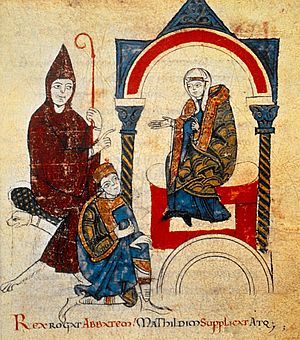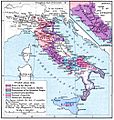Matilda of Tuscany facts for kids
Quick facts for kids Matilda of Canossa |
|
|---|---|

Matilda of Canossa and Hugh of Cluny as advocates of Henry IV
|
|
| Margravine of Tuscany | |
| Reign | 1055–1115 |
| Predecessor | Frederick |
| Successor | Rabodo |
| Regent | Beatrice of Bar 1052–1069 Godfrey III 1053–1069 |
| Co-rule | Godfrey IV 1069–1076 Welf II 1089–1095 |
| Born | c. 1046 Lucca or Mantua |
| Died | 24 July 1115 (aged 68–69) Bondeno di Roncore, Reggiolo, Margraviate of Tuscany |
| Burial | Polirone Abbey (until 1633) Castel Sant'Angelo (until 1645) St. Peter's Basilica (since 1645) |
| Spouse |
|
| House | House of Canossa (Attonids) |
| Father | Boniface III, Margrave of Tuscany |
| Mother | Beatrice of Lorraine |
Matilda of Tuscany (Italian: Matilde di Canossa Latin: Matilda, Mathilda; c. 1046 – 24 July 1115), was a member of the House of Canossa (also known as the Attonids) and one of the most powerful nobles in Italy in the second half of the eleventh century.
She ruled as a feudal margravine and, as a relative of the imperial Salian dynasty, she brokered a settlement in the so-called Investiture Controversy. In this extensive conflict with the emerging reform Papacy over the relationship between spiritual (sacerdotium) and secular (regnum) power, Pope Gregory VII dismissed and excommunicated the Holy Roman Emperor Henry IV in 1076. At the same time, she came into possession of a substantial territory that included present-day Lombardy, Emilia, the Romagna and Tuscany, and made the Canossa Castle, in the Apennines south of Reggio, the centre of her domains.
In January 1077, Henry IV was, after his famous penitential walk in front of the Canossa (Latin: Canusia) Castle, accepted back into the church community by the Pope. The understanding between the Emperor and the Pope was short-lived, however. In the conflicts with Henry IV that arose a little later, Matilda put all her military and material resources into the service of the Papacy from 1080. Her court became a refuge for many displaced persons during the turmoil of the investiture dispute and experienced a cultural boom. Even after Pope Gregory VII's death in 1085, Matilda remained an important pillar of the Reform Church. Between 1081 and 1098, the Canossa rule fell into a major crisis due to the grueling disputes with Henry IV. The historical record is sparse for this time. A turning point resulted from a coalition of Matilda with the southern German dukes, who were in opposition to Henry IV.
After Henry IV's retreat in 1097 past the Alps to the empire's north, a power vacuum developed in Italy. The struggle between regnum and sacerdotium changed the social and rulership structure of the Italian cities permanently and gave them space for emancipation from foreign rule and communal development. From autumn 1098 Matilda was able to regain many of her lost domains. Until the end she tried to bring the cities under her control. After 1098, she increasingly used the opportunities offered to her to consolidate her rule again. In her final years she was worried about her own memory, which is why the childless Matilda focused her donation activity on the Polirone Abbey rather than find a suitable heir.
Sometimes called la Gran Contessa ("the Great Countess") or Matilda of Canossa after her ancestral castle of Canossa, Matilda was one of the most important figures of the Italian Middle Ages. She lived in a period of constant battles, intrigues and excommunications, and was able to demonstrate an innate leadership ability, even during difficult times.
Between 6 and 11 May 1111, Matilda was reportedly crowned Imperial Vicar and Vice-Queen of Italy by Henry V, Holy Roman Emperor at the Castle of Bianello (Quattro Castella, Reggio Emilia), following the account of Donizo. With her death, the House of Canossa became extinct in 1115. Popes and emperors fought over their rich inheritance, called the "Matildine domains", well into the 13th century. Matilda became a myth in Italy, which found its expression in numerous artistic, musical and literary designs as well as miracle stories and legends. This legacy reached its peak during the Counter-Reformation and the Baroque Period. Pope Urban VIII had Matilda's body transferred to Rome in 1630, where she was the first woman to be buried in Saint Peter's Basillica.
Images for kids
-
Adalbert-Atto of Canossa and his wife Hildegard surrounded by arches, and their sons Rudolph, Geoffrey (Gotofred) and Tedald at their feet. Donizo's Vita Mathildis (Vatican Library, Codex Vat. Lat. 4922, fol. 20v)
-
The states of the Apennine Peninsula in the second half of the 11th century.
-
Anselm of Canterbury hands over his work to Matilda. Miniature in a manuscript by Anselm's Orationes (Diocese of Salzburg, around 1160). Admont, Abbey Library, Ms. 289, fol. 1v.
-
Gospels of Matilda of Tuscany, San Benedetto Po (al Polirone), before 1099. New York, Morgan Library & Museum, MS M.492, fol. 84r.
See also
 In Spanish: Matilde de Canossa para niños
In Spanish: Matilde de Canossa para niños








